by Charles Hugh Smith
A guest essay by Eric A. questions our attraction to Armageddon and addresses food security.
Once again I welcome a guest essay by longtime contributor Eric A. This two-part essay asks if we are already in a Depression, and speaks to the resilience of human communities. Part 2 (to be published tomorrow) will address time-tested ways of increasing our food security that are within reach of many of us.
Lately John Michael Greer has been popping up in the blogosphere with well-thought and well-researched insights about the Arc of Empires throughout history. He proposes that like Spengler and others have proposed, Empire rises in a certain recognizable fashion, peaks in a certain fashion, but most importantly falls in a predictable fashion.
Any cursory look at history will tell you this is true, but is likewise easily understood from systems analysis: an Empire, by definition, is the process of extracting wealth from the periphery to the core. What happens once the colonies, frontier, the developing world is already paying all possible tribute?
The only remaining expansion is to both expand the periphery by colonizing ones own citizens, and to shrink the Core to ever-fewer insiders, both of which we see now. Ultimately, the core becomes an oligarchy of a few dozen while the colonized people become everyone else in the system--a 99.9999% vs the 0.0001%, an unstable situation that predictably collapses.
Greer has two returning points with this: one is that this never leads to the end of the world, and the implied point I remarked on in my previous essay: that these things unfold in their own time over the expanse of many years.
The attraction to believe in cultural, financial, or ecological Armageddon is deeply compelling. One can even find data to support these beliefs from commentators or scientists that share one’s outlook. However, in over 2,000 years this has never turned out to be the case. Let’s take two sudden and remarkable ones: The Crash of 1929 and "The Year Without a Summer" in 1816.
The Crash of 1929 and the Great Depression is well-known by this chart: 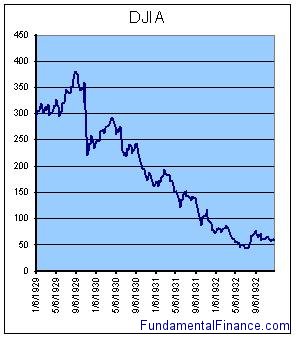
A 90% loss of value for the proxy of the largest US companies. This was accompanied by the closure of hundreds of banks and the confiscation of savings accounts, along with a drop of trade by 60%, GDP by 25%, and a rise in unemployment to 25%. 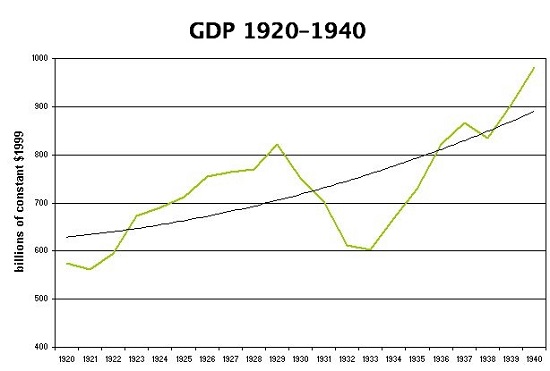
This was a sudden, severe break in events that had broad, deep repercussions. Was it severe, unprecedented even? Yes. Yet even with a crash of this magnitude, what happened? 99% of people tightened their belts, made do, and carried on. 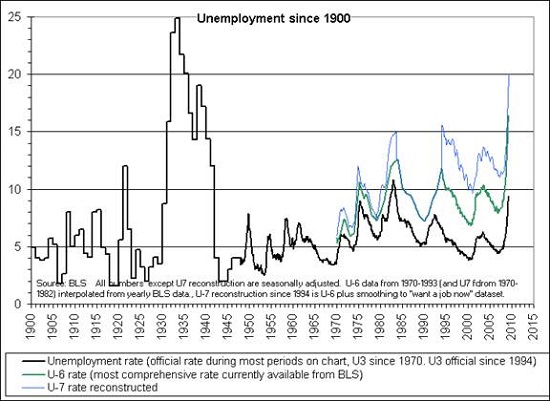
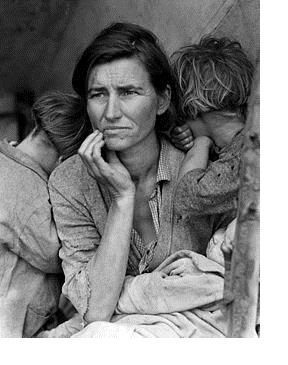
There were points of extreme desperation recorded by photographers such as Dorothea Lange and writers like Steinbeck, however, this under-reports the same conditions throughout the previous 100 years of Industrialization, such as the Massachusetts child mill workers, the Ludlow Coal Massacre of 1914, or the beating or shooting workers during the steel strike of 1919. Although the numbers and locations fluctuate, there are poor people and oppressive conditions in all countries at all times. We need to compare the average trouble to the peak trouble.
So let’s compare: you see the unemployment rate on the right hand of the above chart? That’s us.
Statisticians such as John Williams, using a consistent methodology between then and now, mark our present unemployment rate as high as 25% -- the same as during the Great Depression. He also records a 2% drop in GDP every year for 8 years, or a 20% drop in GDP—same as the Great Depression. How did it feel in 1935? How does it feel now to you now? Because that’s how it was. 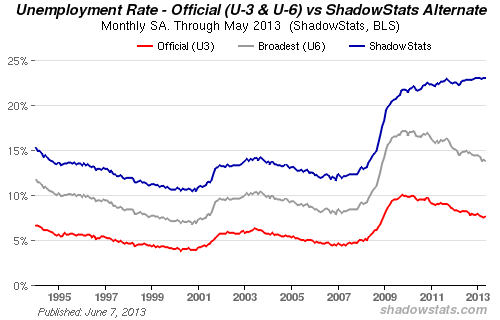
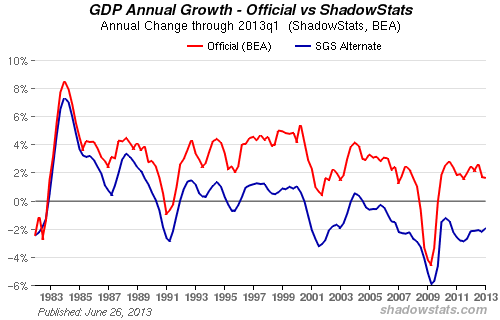
So what should we do to prepare for the Great Depression? Well, I hate to inform you, but it’s already too late. We’re already in it, so you already know what should you have done in 2001, 2007 or now.
Is it Armageddon? Would stocking beans or bullets in 1999 or 2005 have been helpful to you? For more on this subject, you could read reports from other countries where similar things have happened, writer FerFal from Argentina for instance, or Selco from the war in Serbia, but I think you’ll find the same thing: the problem did not happen that fast, nor did the world end.
Challenges were mostly composed of steadily increasing economic pressure with ever-increasing risks of failure. Rent, taxes, debt, sickness, crime: the same challenges as in the good times, only harder.
But the Depression is surely light stuff: let’s move on to an epic ecological catastrophe, the "Year Without a Summer".
In 1815, Mount Tambora in Indonesia exploded with earth-shaking force. It was the largest eruption in 1,300 years, with an explosion audible in Sumatra 2,000km away. Volcanic ash filled the skies, blotting out the sun, and snow fell in Albany in June. River ice flowed in Pennsylvania in July. Frost fell every month of the year in areas of Canada, the US, and Europe. The entire crop was lost before the bitter and endless winter of 1817 where deep-harbor New York recorded temperatures of -26 F (-32 C). Prices rose suddenly through the western world and food riots broke out. This is as close as the modern world has ever come to a nuclear holocaust and nuclear winter.
Never heard of it? That’s odd. You would think the largest explosion and climate event in 1,300 years would have more effect on daily life.
And that’s my point. The world doesn’t end. Nor does it change very quickly or without going through a long series of steps.
I could recount the 85 Million killed in World War II, the 200 Million killed by the Black Death in the 1300s, Communist purges of Stalin and Mao and so on, but the point is the same: things don’t change very quickly or very much. In fact, we’re already in the middle of the next great crisis and you didn’t notice. So are things going to suddenly change tomorrow, next week, next year?
I bring this up because what we THINK will happen determines what we DO in response. For many this has been ignoring risks completely, complete with buying new houses, investing in that 401k, and taking Caribbean Cruises. For others, it’s to stock up on guns, canned goods, and bunker down waiting for the zombie apocalypse.
I propose neither way is sensible, because of the way the world changes ponderously and one step at a time.
Our emotional desire to find either a return to normal or an instant end of everything colors our approach, fatally compromising our ability to accurately prepare for real challenges that are far more likely or even certain. However, comparing to previous crises we can reliably predict what is most likely to happen and where our real risks lie.
As there are a constellation of risks, let’s just take one example of risk and its solution, that I’m personally familiar with: Food Security.
Do you need food security? With 1 in 5 Americans on food stamps and a 25% unemployment rate, I’m going to guess that if you don’t need it already, there’s a good possibility you will in the future. 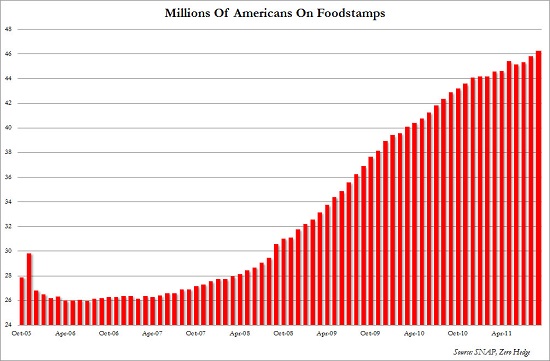
And that’s only for economic reasons: looking back over history we find major wars with rationing at 70-year intervals. Then there are unique events like Tambora, the Dust Bowl, or has been lately suggested, Global Warming and/or violent weather.
In addition, modern food crops are far more concentrated than ever in history. Concentrated into geographical regions with certain requirements such as oil-hungry irrigation, planting, tilling, and harvesting equipment that will be expensive if not impossible to continue. Concentrated also genetically, where 5 major crops account for most of the calories grown on earth, and of those, a huge proportion are similar strains (corn, wheat) if not near-clones of each other (bananas, Holsteins). This is in addition to the ever-fewer seed producers and the enormous increase in GMO and terminator seeds.
And this is presuming that we have the money to buy food or that we won’t be turned out of our homes by eviction, foreclosure, or war.
With such a variety of factors, how do we create a food plan? By looking to history, of course.
Starting with our two events, how could one have best prepared? Preparations for 1816 are simple: enough food for 1-2 years along with a reserve of heating fuel for the pounding winter of '17. Alternately, you could say that food was available even in this hard time—the problem was price, not availability. So arguably one could have stored a year’s worth of either food or money.
At the same time, if you had stored food only, the 1816 economy was 90% farming: you might have lost the house or farm with the lack of crop income while town dwellers could be evicted away from their pantry when high fuel prices caused them to miss rent. Looked at another way, you could say that food rose sharply in price relative to money and rent. So if you had food in store, you could have sold it to get by--under those conditions, storing food WAS storing money.
How does this compare to the 1929? In the Depression, wholesale prices collapsed and food got far cheaper—but only if you could find the scarce money to buy it with. The Depression wasn’t over in a year, either, but lasted from '29 through '39, then through 1945 with the war rationing for over 20 years of grinding hardship. In Europe, the food and fuel crisis persisted far longer as whole nations were tediously reconstructed from rubble.
While storing food might have helped a little, it’s clearly unrealistic both to buy 10 years’ worth ahead of time and expect to store it safely through the greatest turmoil of the 20th century. If instead you had stored money, you might have done well in America, but only if you were outside stocks, bonds, banks, commodities and real estate. And storing money in the battle zones of Europe would not have been much help at all.
Two very different events with two very different responses, and with food concentration and weather volatility, our needs are different again today. Is there any way to create food stability at low cost, with broad genetic, political, and weather stability with low storage requirements?
Let me ask you a question: why are you storing food in the first place? Is it to eat it? And where does food come from? From the cupboard, from the store, from your paycheck? No. It comes from the ground.
We live in a money paradigm. All things are delivered for money (trade). All goods are compared to money (prices). Then we live and die by our trade and the money-signals that prices give us. Stop trade, wobble the prices around, and we starve by millions.
We also swim in a consumer paradigm. We work to get people halfway around the world buy our stuff so that we can buy stuff back from them. Why? If you want an apple, which is easier: to work, trade that work for money through the online banking system, have money load that apple on a tractor in New Zealand, ship it to a warehouse, a cargo ship, a truck, a store, your car, then your mouth? Or is it easier just to go in the back yard and pick one?
Worried about prices? All those middle men must be paid, from New Zealand to New Hampshire. Which do you think is cheaper? Which do you think is more reliable? Which do you think tastes better?
What I’m saying is, if you want food, then GO MAKE FOOD. Be a producer, not a consumer. And the best part is that if you produce food, whether by seed or tree, it will produce over and over for 10, 20 or 100 years. Through the long Depression. You can sell it in a war or food interruption. You can pick varieties that do not require inputs of oil or water and are not susceptible to genetic crisis. Even if you get turned out, seeds are small, legal, valuable, and the skill to grow them is easily transported. For stability, for price, for size, for long-term reliability, nothing beats making your own.
How do you get cheap food stability? Make it yourself. In Part Two I’ll cover a variety of ways ordinary people can create their own food plan.
copyright 2013 by Eric A.
No comments:
Post a Comment